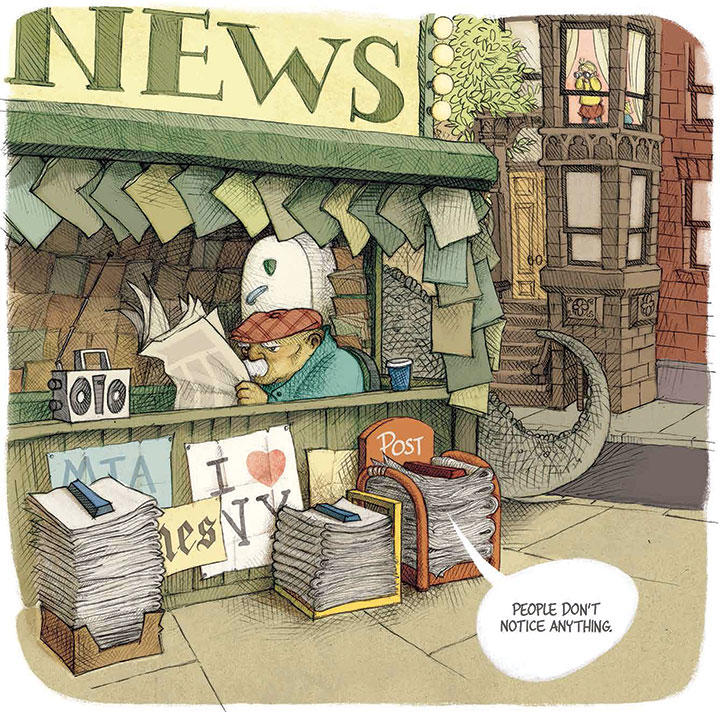One day, many years ago, the mayor of New York City was transformed into a dinosaur. To announce this momentous change, he held a press conference, only to discover that the jaded citizenry didn’t care. That was the story told by Sean Rubin ’09’s Uncle Eddie, who had a habit of concocting far-fetched tales starring Rubin’s toys. This story stuck.

“I was around 17 at the time — we’re a funny family — and I started writing out the story when I realized: If there were a dinosaur in New York, nobody would care,” Rubin says. Uncle Eddie put a dinosaur in New York City, and Rubin started asking questions about him: His new book, Bolivar (Archaia) is what came next.
Writer and illustrator Rubin, who grew up in Brooklyn, crafted his protagonist in the mold of a typical Gothamite: He reads The New Yorker; he likes jazz; he goes to museums; he eats corned beef sandwiches: “[Bolivar’s] character seems to be the sort that people swear they’ve encountered,” he says.
Rubin’s detail-rich illustrated homage to his uncle’s imagination fits into an emergent genre seeking to bridge the gap between image-based stories and novels. According to Rubin, librarians see these volumes, sometimes called chapter books, as a springboard for young readers transitioning into pictureless prose.
Rubin shows Bolivar’s life mostly as glimpsed from the vantage point of his precocious 8-year-old next-door neighbor, Sybil, who is fixated on photographing the elusive dinosaur whom no one else seems to notice.
Her attempts take readers through an autumnal jaunt across a New York cityscape set in the mid-’90s, about the time when Rubin was Sybil’s age. “The city is always changing. So I found it was more authentic to draw it from memory,” he says. “In some ways, the memories sort of became more real.”For eagle-eyed readers, there are several references to Princeton ensconced in Rubin’s intricately detailed scenes: orange-and-black scarves, hats, and umbrellas tucked into background scenery; a University seal secretly etched into a brick façade; a sly nod to a famous Princeton politician folded into the rendering of the city’s mayor.
Rubin has been drawing since he could hold a pencil, but he says: “It’s not so much when I started drawing — most children draw — it’s that I never stopped.”
As he got older, he began sketching characters and scenes from the Redwall book series, an anthropomorphic medieval realm of sword-wielding mice and their woodland compatriots. At a Redwall book signing when Rubin was 13, his parents urged him to show his work to the author, Brian Jacques. Rubin was reticent, but the introduction was a turning point: Jacques was so impressed he arranged for the teen to start contributing art for his website and for Redwall audiobook covers. Then, in his final year in Princeton, Rubin was asked to illustrate an entire Redwall book, which led to other work through the years.
In 2011, as he stopped taking on large illustration jobs, Rubin began concentrating on Bolivar while also starting a company that makes safe surfaces for pools and water parks. In illustrating the book, Rubin undertook every aspect of production himself, including hand lettering and an old-school approach to producing layouts — physically cutting and Scotch-taping his characters into sample configurations before drawing the final, crosshatching-heavy product.
The book, at 224 pages, is a bit daunting for story-time reading, Rubin concedes, but he divided it into five manageable chapters — one for each bedtime during the week.
Rubin is relieved that five years later the book is complete, but he is already thinking ahead: “This is not the last we’ve seen of Sybil and Bolivar,” he says. “I’m looking forward to working with the characters for years.”













No responses yet